
The Ashoka Chakra is India's highest peacetime military decoration awarded for valor, courageous action, or self-sacrifice away from the battlefield. It is the peacetime equivalent of the Param Vir Chakra (PVC) and is awarded for the "most conspicuous bravery or some daring or pre-eminent valour or self-sacrifice" other than in the face of the enemy. The decoration may be awarded either to military or civilian personnel.
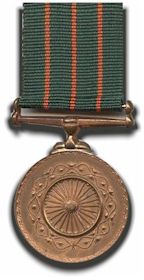
The Shaurya Chakra is an Indian military decoration awarded for valour, courageous action or self-sacrifice while not engaged in direct action with the enemy. It may be awarded to civilians as well as military personnel, sometimes posthumously. It is third in order of precedence of peacetime gallantry awards and comes after the Ashoka Chakra and the Kirti Chakra. It precedes the Yudh Seva Medal.

The Kirti Chakra is an Indian military decoration awarded for valour, courageous action or self-sacrifice away from the field of battle. It may be awarded to civilians as well as military personnel, including posthumous awards. It is the peacetime equivalent of the Maha Vir Chakra. It is second in order of precedence of peacetime gallantry awards, comes after Ashoka Chakra and before Shaurya Chakra. Before 1967, the award was known as the Ashoka Chakra, Class II.
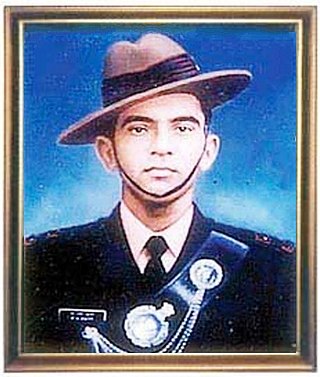
Second Lieutenant Puneet Nath Datt, AC was an officer of the Indian Army's 11 Gorkha Rifles. He was posthumously awarded India's highest peacetime gallantry award, the Ashok Chakra, for bravery displayed in an Indian Army operation. The operation was conducted against terrorists hidden in a three-story building in the Nowshera area of Srinagar, Jammu and Kashmir.

Mohan Chand Sharma AC was an Indian police officer who was martyred during the 2008 Batla House encounter in New Delhi. He was posthumously awarded the Gallantry medal Ashoka Chakra Award, India's highest peacetime military decoration, on 26 January 2009.

Shri Randhir Prasad Verma, AC was an Indian police officer who was killed in action while fighting off a robbery attempt at a bank in Dhanbad, Jharkhand, India. He was posthumously awarded the gallantry award Ashoka Chakra. The Government of India also issued a Commemorative postage stamp in his honor in 2004.

Colonel Vasanth Venugopal, AC was an Indian Army officer. He was the commanding officer of the 9th battalion, Maratha Light Infantry. On 31 July 2007, he was Attained veergathi in action while preventing heavily armed infiltrators from crossing the India-Pakistan border at Uri, Jammu and Kashmir. As a result he was posthumously awarded the Ashoka Chakra, India's highest military decoration for peacetime gallantry.

KLVSNV Prasad Babu AC was an Indian police officer belonging to the Greyhounds special operations group of the Andhra Pradesh Police. In 2013 he was posthumously awarded the Ashoka Chakra, India's highest peacetime gallantry award, after he played a vital role in the death of nine Maoists and helped save the lives of four officers.
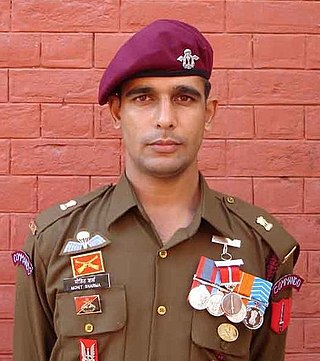
Major Mohit Sharma was an Indian Army Officer who was posthumously awarded the Ashoka Chakra, India's highest peace-time military decoration. Maj Sharma was from the elite 1st Para SF.

Colonel Jojan Thomas, AC was an Indian military officer with the Jat Regiment and later the 45 Rashtriya Rifles unit. He was a native of Kuttoor in Thiruvalla, Kerala and lived in Bangalore. He was commissioned from the Officers Training Academy, Chennai in March 1986. On 22 August 2008, he led an operation against terrorists in the forests of Macchal sector in the Kupwara district of Jammu and Kashmir. In the process, he killed three terrorists, but sustained several gunshot wounds and succumbed to injuries. For his bravery, he was posthumously awarded the Ashoka Chakra, the highest peace time military decoration in India.

Major Dinesh Raghu Raman, AC was an Indian military officer with the 19th Battalion of the Jat Regiment who was posthumously awarded India's highest peacetime military decoration Ashoka Chakra.
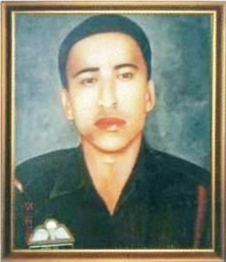
Paratrooper Sanjog Chhetri, AC was an Indian soldier and a recipient of the Ashoka Chakra, India's highest peace time military decoration.He was posthumously awarded the Ashoka Chakra for his actions during an Indian Army counterterrorism operation on 22 September 2002 while serving with the 9 Para. He is the youngest recipient of the Ashoka Chakra.

Major Sudhir Kumar Walia, AC, ADC, SM & Bar, was an officer of the Indian Army, who served in the elite 9 Para (SF). He was posthumously awarded the Ashoka Chakra, India's highest peacetime military decoration, by the then President, late K. R. Narayan, in January 2000.
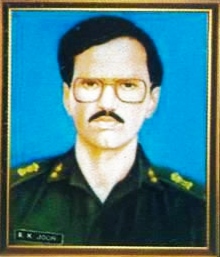
Major Rajiv Kumar Joon, AC, SC was a highly decorated Officer in the Indian Army. He was posthumously awarded the Ashoka Chakra, India's highest peace-time military decoration. He was previously decorated with the Shaurya Chakra, the third-highest peacetime military decoration.

Subedar Sujjan Singh Yadav, AC was an Indian Army Junior Commissioned Officer (JCO) with the 13th Battalion of the Kumaon Regiment. He was awarded the highest peace time gallantry award Ashoka Chakra posthumously for his action in Operation Rakshak in Kupwara, Jammu and Kashmir.
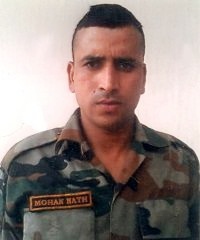
Lance Naik Mohan Nath Goswami AC was a soldier in the 9 Para (SF) of the Parachute Regiment of the Indian Army. He was posthumously awarded the Ashoka Chakra, India's highest peacetime military decoration. On 3 September 2015, while serving with the 9th battalion of the Parachute Regiment, Goswami was killed in an ambush operation while fighting four terrorists in Kupwara district, Jammu and Kashmir. For his actions in Kupwara, he was posthumously awarded the Ashoka Chakra.

Pramod Kumar Satapathy, AC was the Assistant Commandant of the Special Operation Group of Odisha Special Armed Police, which comes under India's Odisha Police who was awarded India's highest peace time gallantry award Ashoka Chakra.
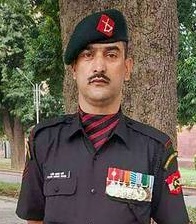
Lance Naik Nazir Ahmad Wani, AC, SM & Bar was an Indian Army soldier and a recipient of the Ashoka Chakra, India's highest peacetime military decoration.At the time of his death, he was serving with an auxiliary battalion of the army's Jammu and Kashmir Light Infantry Regiment, the 162nd Infantry Battalion of the Territorial Army .He was posthumously awarded the Ashoka Chakra for his actions during a counterterrorism operation in which his unit was attached with the 34th Rashtriya Rifles battalion. He was the first recipient of the Ashok Chakra from Jammu and Kashmir.
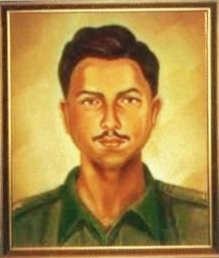
Captain Eric James Tucker, AC was an Indian Army officer who was Posthumously awarded the highest peace time gallantry award, Ashok Chakra for an act of Gallantry in Nagaland.
Assistant Sub-inspector Babu Ram, AC (1972–2020) was a Police Officer of the Special Operations Group (SOG) Srinagar, who was awarded the highest peace time gallantry award, the Ashok Chakra.



















